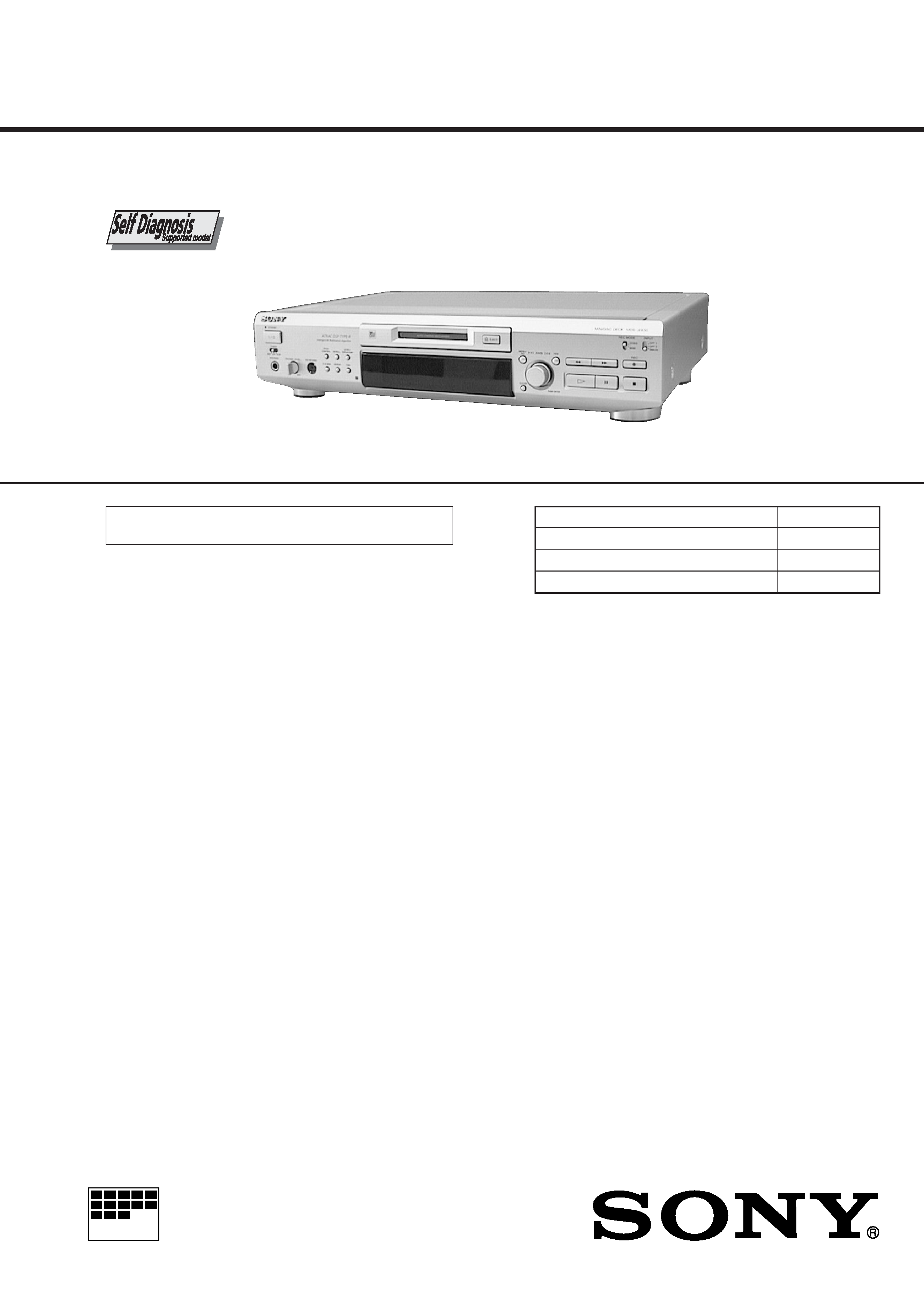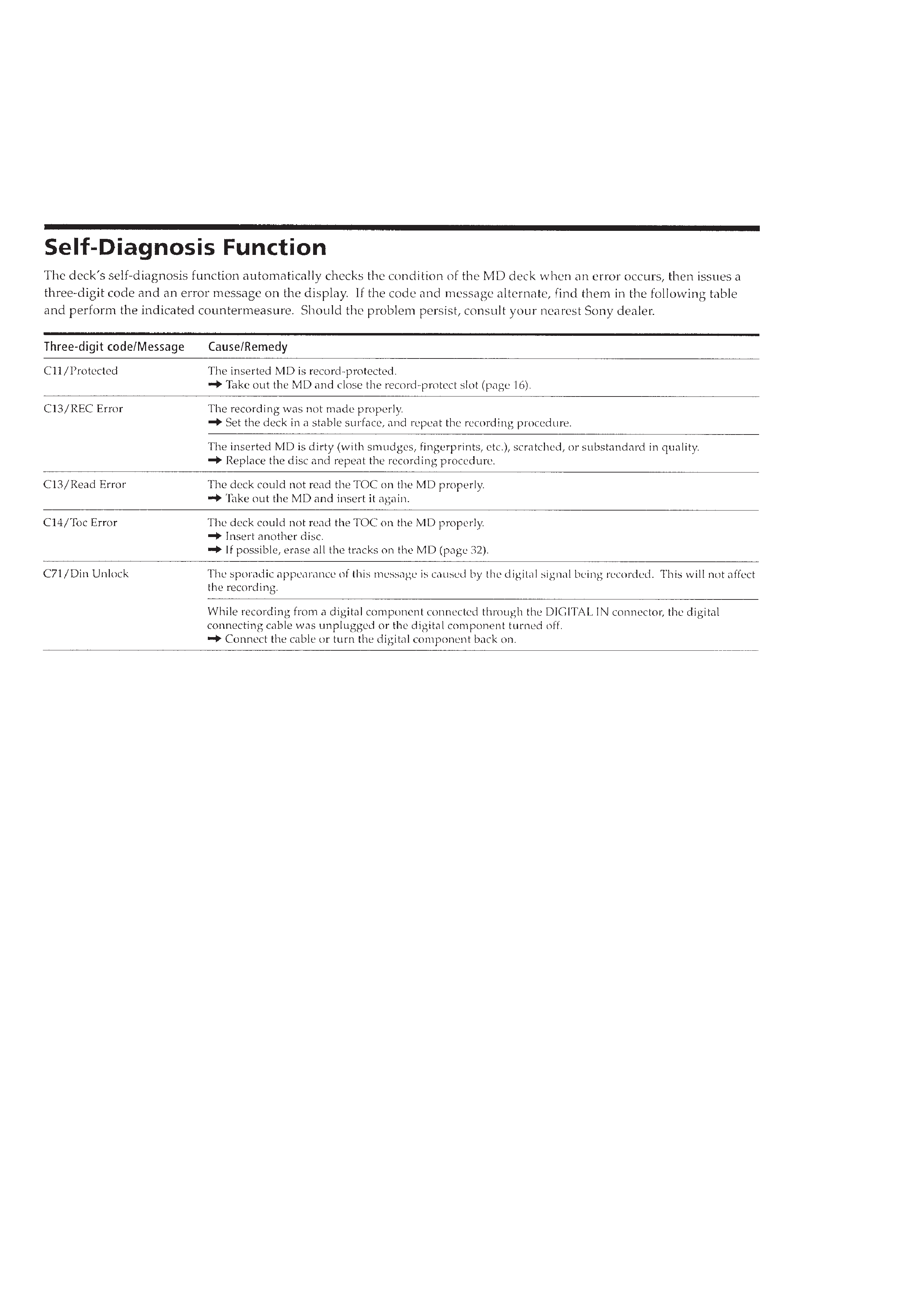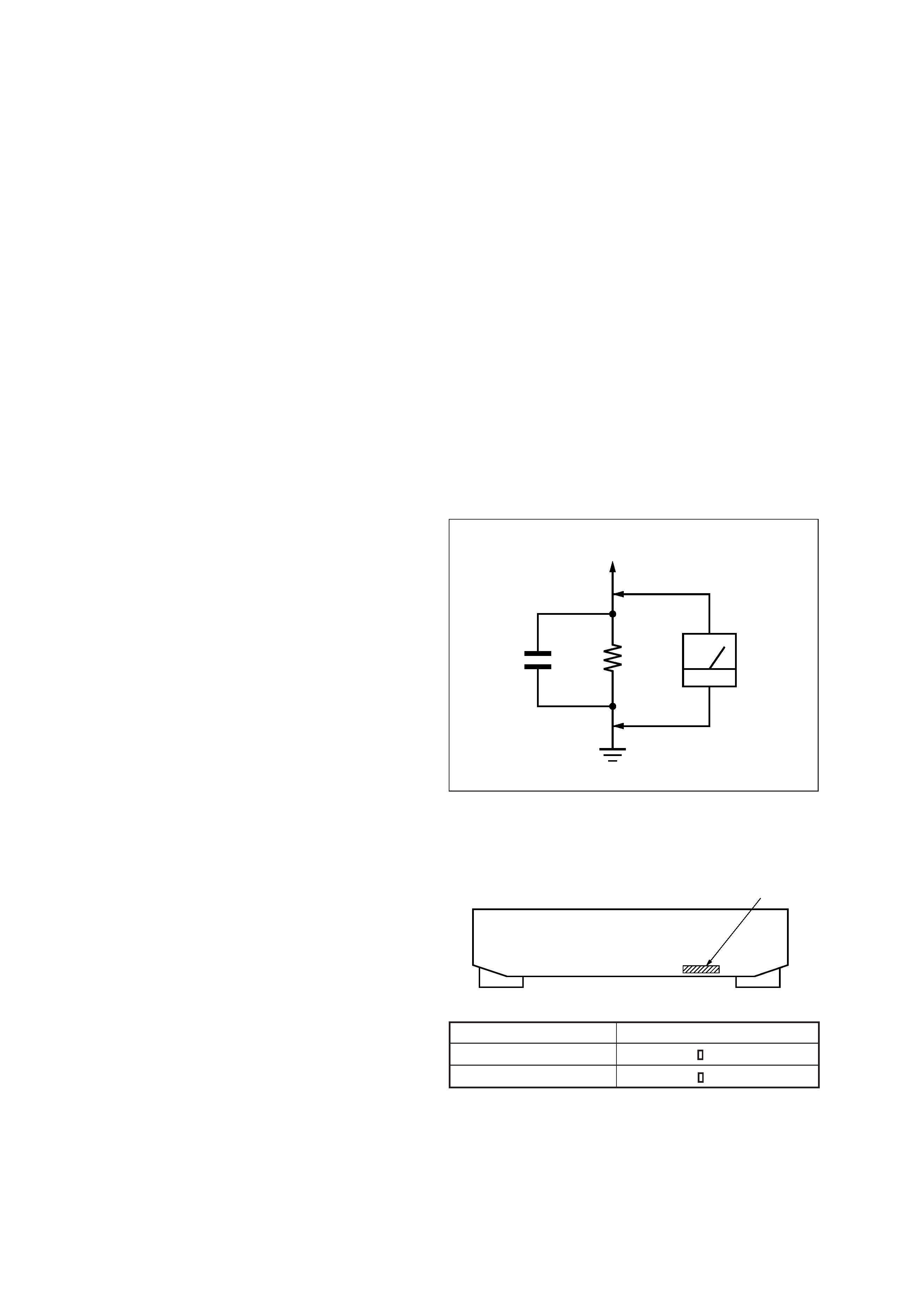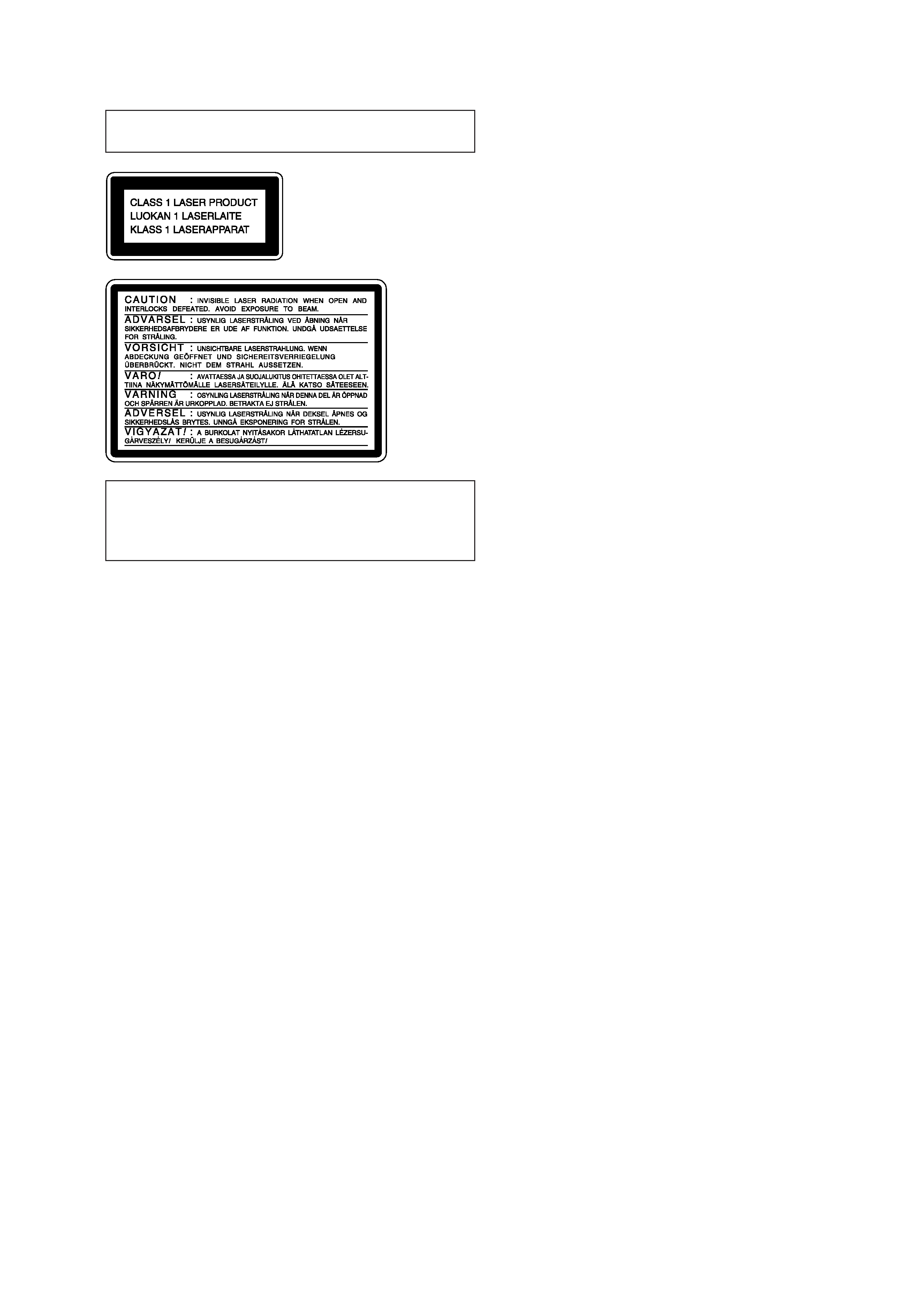
MICROFILM
SERVICE MANUAL
MINIDISC DECK
US Model
Canadian Model
SPECIFICATIONS
MDS-JE630
U.S. and foreign patents licensed form Dolby Laboratories
Licensing Corporation.
System
MiniDisc digital audio system
Disc
MiniDisc
Laser
Semiconductor laser (
= 780 nm)
Emission duration: continuous
Laser output
Less than 44.6 µW*
* This output is the value measured
at a distance of 200 mm from the
objective lens surface on the Optical
Pick-up Block with 7 mm aperture.
Laser diode
Material: GaAlAs
Revolutions (CLV)
400 rpm to 900 rpm
Error correction
Advanced Cross Interleave Reed
Solomon Code (ACIRC)
Sampling frequency
44.1 kHz
Coding
Adaptive Transform Acoustic Coding
(ATRAC)
Modulation system
EFM (Eight-to-Fourteen Modulation)
Number of channels
2 stereo channels
Frequency response
5 to 20,000 Hz ±0.3 dB
Signal-to-noise ratio
Over 98 dB during playback
Wow and flutter
Below measurable limit
Inputs
LINE (ANALOG) IN
Jack type: phono
Impedance: 47 kilohms
Rated input: 500 mVrms
Minimum input: 125 mVrms
DIGITAL IN
Connector type: square optical
Impedance: 660 nm (optical wave length)
Outputs
PHONES
Jack type: stereo phone
Rated output: 28 mW
Load impedance: 32 ohms
LINE (ANALOG) OUT
Jack type: phono
Rated output: 2 Vrms (at 50 kilohms)
Load impedance: over 10 kilohms
DIGITAL OUT
Connector type: square optical
Rated output: 18 dBm
Load impedance: 660 nm (optical
wave length)
General
Power requirements
120 V AC, 60 Hz
Power consumption
17 W
Dimension (approx.)
430
× 95 × 280 mm
(17
× 3 3/4 × 11 1/8 in.) (w/h/d) incl.
projecting parts and controls
Mass (approx.)
3.4 kg (7 lbs 11 oz)
Supplied accessories
· Audio connecting cords (2)
· Optical cable (1)
· Remote commander (remote) RM-D15M (1)
· R6 (size-AA) batteries (2)
Design and specification are subject to change without notice.
Model Name Using Similar Mechanism
MDS-JE520
MD Mechanism Type
MDM-5D
Base Unit Type
MBU-5D
Optical Pick-up Type
KMS-260B/J1N

2
SELF-DIAGNOSIS FUNCTION
The self-diagnosis function consists of error codes for customers which are displayed automatically when errors occur, and error codes
which show the error history in the test mode during servicing. For details on how to view error codes for the customer, refer to the
following box in the instruction manual. For details on how to check error codes during servicing, refer to the following "Procedure for
using the Self-Diagnosis Function (Error History Display Mode)".
PROCEDURE FOR USING THE SELF-DIAGNOSIS FUNCTION (ERROR HISTORY DISPLAY MODE)
Note: Perform the self-diagnosis function in the "error history display mode" in the test mode. The following describes the least required procedure. Be
careful not to enter other modes by mistake. If you set other modes accidentally, press the MENU/NO button to exit the mode.
1. While pressing the [ AMS ] knob and p button, connect the power plug to the outlet, and release the [ AMS ] knob
and p button.
2. Turn the [ AMS ] knob and when "[Service]" is displayed, press the [YES] button.
3. Turn the [ AMS ] knob to display "ERR DP MODE".
4. Press the [YES] button to sets the error history mode and displays "total rec".
5. Select the contents to be displayed or executed using the [ AMS ] knob.
6. Press the [ AMS ] knob to display or execute the contents selected.
7. Press the [ AMS ] knob another time returns to step 4.
8. Press the [MENU/NO] button to display "ERROR DP MODE" and releases the error history mode.
9. To release the test mode, press the [REPEAT] button. The unit sets into the STANDBY state, the disc is ejected, and the test mode
ends.
±
±
[ ]
±
±
[ ]
±
±
±

3
ITEMS OF ERROR HISTORY MODE ITEMS AND CONTENTS
Selecting the Test Mode
Display
Details of History
E00
No error
E01
Disc error. PTOC cannot be read
(DISC ejected)
E02
Disc error. UTOC error
(DISC not ejected)
E03
Loading error
E04
Address cannot be read (Servo has deviated)
Table of Error Codes
Error Code
Error Code
Details of Error
total rec
Displays the recording time.
Displayed as "rh".
The displayed time is the total time the laser is set to the high power state.
This is about 1/4 of the actual recording time.
The time is displayed in decimal digits from 0h to 65535h.
total play
Displays the play time.
Displayed as "ph". The time displayed is the total actual play time. Pauses are not counted.
The time is displayed in decimal digits from 0h to 65535h.
retry err
Displays the total number of retries during recording and number of retry errors during play.
Displayed as "r p".
"r" indicates the retries during recording while "p" indicates the retry errors during play.
The number of retries and retry errors are displayed in hexadecimal digits from 00 to FF.
total err
Displays the total number of errors.
Displayed as "total ".
The number of errors is displayed in hexadecimal digits from 00 to FF.
err history
Displays the 10 latest errors.
Displayed as "0 E@@".
indicates the history number. The smaller the number, the more recent is the error. (00 is the latest).
@@ indicates the error code.
Refer to the following table for the details. The error history can be switched by turning the [ AMS ]
knob.
er refresh
Mode which erases the "retry err", "total err", and "err history" histories.
When returning the unit to the customer after completing repairs, perform this to erase the past error history.
After pressing the [ AMS ] button and "er refresh?" is displayed, press the [YES] button to erase the
history.
"Complete!" will be displayed momentarily.
Be sure to check the following when this mode has been executed.
· The data has been erased.
· The mechanism operates normally when recording and play are performed.
tm refresh
Mode which erases the "total rec" and "total play" histories.
These histories serve as approximate indications of when to replace the optical pick-up.
If the optical pickup has been replaced, perform this operation and erase the history.
After pressing the [ AMS ] button and "tm refresh?" is displayed, press the [YES] button to erase the
history.
"Complete!" will be displayed momentarily.
Be sure to check the following when this mode has been executed.
· The data has been erased.
· The mechanism operates normally when recording and play are performed.
±
±
±
E05
FOK has deviated
E06
Cannot focus (Servo has deviated)
E07
Recording retry
E08
Recording retry error
E09
Playback retry error
(Access error)
E0A
Playback retry error (C2 error)
Details of Error

4
SECTION 1
SERVICING NOTES
SAFETY CHECK-OUT
After correcting the original service problem, perform the follow-
ing safety check before releasing the set to the customer:
Check the antenna terminals, metal trim, "metallized" knobs,
screws, and all other exposed metal parts for AC leakage.
Check leakage as described below.
LEAKAGE TEST
The AC leakage from any exposed metal part to earth ground and
from all exposed metal parts to any exposed metal part having a
return to chassis, must not exceed 0.5 mA (500 microamperes).
Leakage current can be measured by any one of three methods.
1. A commercial leakage tester, such as the Simpson 229 or RCA
WT-540A. Follow the manufacturers' instructions to use these
instruments.
2. A battery-operated AC milliammeter. The Data Precision 245
digital multimeter is suitable for this job.
3. Measuring the voltage drop across a resistor by means of a
VOM or battery-operated AC voltmeter. The "limit" indica-
tion is 0.75 V, so analog meters must have an accurate low-
voltage scale. The Simpson 250 and Sanwa SH-63Trd are ex-
amples of a passive VOM that is suitable. Nearly all battery
operated digital multimeters that have a 2 V AC range are suit-
able. (See Fig. A)
Fig. A.
Using an AC voltmeter to check AC leakage.
1.5 k
0.15
µF
AC
voltmeter
(0.75 V)
To Exposed Metal
Parts on Set
Earth Ground
MODEL IDENTIFICATION
-- BACK PANEL --
TABLE OF CONTENTS
SELF-DIAGNOSIS FUNCTION .................................... 2
1.
SERVICING NOTES ............................................... 4
2.
GENERAL ................................................................... 11
3.
DISASSEMBLY ......................................................... 13
4.
TEST MODE .............................................................. 17
5.
ELECTRICAL ADJUSTMENTS ......................... 22
6.
DIAGRAMS
6-1. Block Diagram SERVO Section ............................... 31
6-2. Block Diagram MAIN Section ................................. 33
6-3. Note for Printed Wiring Boards and
Schematic Diagrams ....................................................... 35
6-4. Printed Wiring Board BD Board .............................. 37
6-5. Schematic Diagram BD Board (1/2) ........................ 39
6-6. Schematic Diagram BD Board (2/2) ........................ 41
6-7. Schematic Diagram SW Board ................................. 44
6-8. Printed Wiring Board SW Board .............................. 44
6-9. Printed Wiring Board MAIN Board ......................... 45
6-10. Schematic Diagram MAIN Board (1/2) ................... 47
6-11. Schematic Diagram MAIN Board (2/2) ................... 49
6-12. Printed Wiring Boards PANEL Section ................... 51
6-13. Schematic Diagram PANEL Section ........................ 53
6-14. IC Pin Function Description ........................................... 58
7.
EXPLODED VIEWS ................................................ 65
8.
ELECTRICAL PARTS LIST ............................... 69
Part No.
Model
Part No.
US model
4-216-907-7
Canadian model
4-216-907-8

5
Flexible Circuit Board Repairing
· Keep the temperature of the soldering iron around 270 °C dur-
ing repairing.
· Do not touch the soldering iron on the same conductor of the
circuit board (within 3 times).
· Be careful not to apply force on the conductor when soldering
or unsoldering.
Notes on chip component replacement
· Never reuse a disconnected chip component.
· Notice that the minus side of a tantalum capacitor may be dam-
aged by heat.
CAUTION
Use of controls or adjustments or performance of procedures
other than those specified herein may result in hazardous ra-
diation exposure.
Laser component in this product is capable of emitting radia-
tion exceeding the limit for Class 1.
This appliance is classified as
a CLASS 1 LASER product.
The CLASS 1 LASER PROD-
UCT MARKING is located on
the rear exterior.
This caution
label is located
inside the unit.
ATTENTION AU COMPOSANT AYANT RAPPORT
À LA SÉCURITÉ!
LES COMPOSANTS IDENTIFIÉS PAR UNE MARQUE
!
SUR LES DIAGRAMMES SCHÉMATIQUES ET LA LISTE
DES PIÈCES SONT CRITIQUES POUR LA SÉCURITÉ
DE FONCTIONNEMENT. NE REMPLACER CES COM-
POSANTS QUE PAR DES PIÈCES SONY DONT LES
NUMÉROS SONT DONNÉS DANS CE MANUEL OU
DANS LES SUPPLÉMENTS PUBLIÉS PAR SONY.
SAFETY-RELATED COMPONENT WARNING!!
COMPONENTS IDENTIFIED BY MARK
! OR DOTTED
LINE WITH MARK
! ON THE SCHEMATIC DIAGRAMS
AND IN THE PARTS LIST ARE CRITICAL TO SAFE
OPERATION. REPLACE THESE COMPONENTS WITH
SONY PARTS WHOSE PART NUMBERS APPEAR AS
SHOWN IN THIS MANUAL OR IN SUPPLEMENTS PUB-
LISHED BY SONY.
